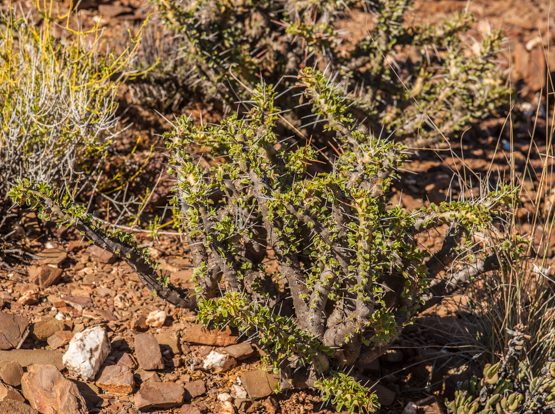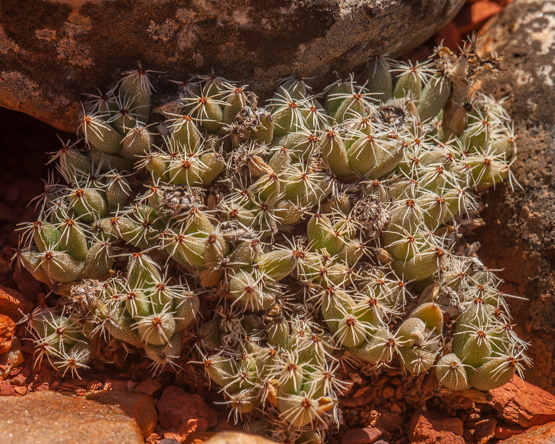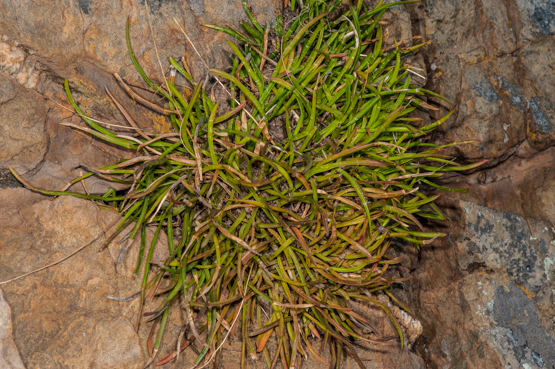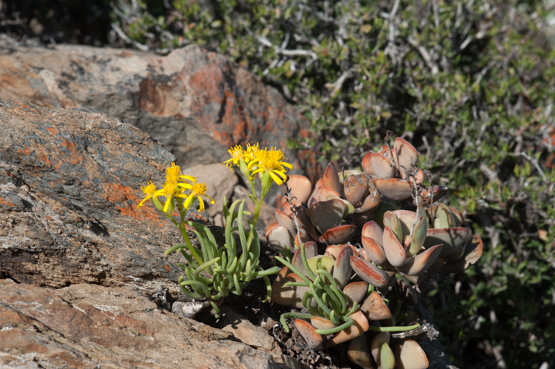In the Montagu area and further to the east and northeast, this species is rather common on quartz patches, in rock crevices and in other stony places. In spite of that, one does not often find it mentioned in the literature.
The species belongs to the group of nicely compact Trichodiademas, of which T. densum is the best known. In the wild, the plants get no taller than 4 cm.
The leaves are beautifully covered in big bladder cells with long points at the tip.
In the description it says that the diadem has 5-10 bristles, but in all the plants I have seen there are about twice as much.
The flowering period is from May through August.
This species can be distinguished from similar ones by the fact that the fruits have 6 compartment, rather than the usual 5.
Tag: Little Karoo
Gibbaeum pubescens and G. shandii (part 3/3)
Gibbaeum pubescens and shandii (part 2/3)
Gibbaeum pubescens and G. shandii (part1/3)
These two species are closely related and often difficult to tell apart at first sight. In fact there is only one cast-iron distinguishing character.
In The Gibbaeum Handbook (1953), G.C. Nel wrote the following with regard to G. shandii:
” This species is related to, and resembles G. pubescens in its general appearance so much that one can only decide after examining the tomentose covering with a hand lens, whether it is G. pubescens or G. shandii. The tomentose covering of G. shandii consists of separate, stellately branched hairs and the underlying greenish epidermis can be seen between the hairs. With the naked eye, the hairy covering seems continuous. The thick tomentose covering of G. pubescens consists of minute simple hairs pointing downwards and closely adpressed to the epidermis, to such an extent that the underlying epidermis is entirely covered by them. These two species occur either together in the same patch or they may be separated, at times, by a short distance. Both these two species form large white greyish cushions of various sizes.”
He then ends his discussion of this species as follows:
“The description of G. pubescens is valid for that of G. shandii. The only important difference is in the nature of the tomentose covering.”
In the light of the above it is not surprising that in 1983, H. F. Glen decided to reduce the rank of these two species to subspecies (G. pubescens ssp. pubescens and G. pubescens ssp. shandii resp).
Both (sub)species occur in the area between Ladismith and Barrydale in the Little Karoo.
The five pictures of G. pubescens ssp. pubescens shown here were taken at the following dates:
1,2: 30 June 2013
3: 14 Sept. 2010
4,5: 26 Sept. 2006
Bulbine succulenta
Why would a plant like this spend a lot of water and energy to produce succulent leaves, only to let them die back when the dry period arrives?
The only reason I can think of is the following: in winter there is a surplus of water, which the woody underground tuber cannot absorb quickly enough.
Leaves, even succulent ones, can grow much faster than tubers, and therefore can store more water in a shorter period. When the weather starts becoming drier and hotter, the water in the leaves is then gradually absorbed by the tuber.
This recycling of water is best known from the mesemb family. It works a bit differently there (for one, very few Mesembs have tubers) but the general idea seems to me to be the same. For more info on this phenomenon, have a look at Water recycling in succulents.
B. succulenta is often locally abundant in the western part of the Little Karoo and further northwards (Tanqua Karoo and Bokkeveld Mts).
Although the leaves in this species may be up to 13 cm long, they are usually much shorter; the width varies from 0.3-1 cm.
The flowers appear from July through September and are yellow (as in nearly all Bulbines).
Pictures are in chronological order:
1 taken 11 July
2 and 3: 4 Sept.
4: 1 Oct.
.
Adromischus triflorus (1)
Many Adromischus species are quite variable and this one is no exception.
Looking at the pictures you will get some idea of the differences in size, colour, markings and shape of the leaves.
A. maculatus is often quite similar, but there the horny leaf margin runs all around the circumference of the leaves, whereas in A. triflorus it is only present in the upper half.
The species occurs on lower sandstone slopes and rocky outcrops from Clanwilliam to Worcester, Mossel Bay and Steytlerville; in the Little Karoo it is the most common Adromischus.
The relatively large flowers appear from November to January.
Haworthia blackburniae var. blackburniae
If you are after sheer visual beauty, this species will not be high on your list. Nevertheless it is of great interest, because no other Haworthia looks quite like it. With their long narrow leaves (sometimes over 30 cm long) the plants could often easily be taken for clumps of grass.
They are found from the Calitzdorp area westward to Anysberg, usually on shaded -and therefore relatively cool and damp- southern slopes. In more open, drier and hotter spots, the plants stay much smaller, as you can see in the first three pictures.
Senecio cotyledonis (2)
Senecio cotyledonis (1)
When the Swiss botanist Augustin de Candolle described this species in 1838, he apparently saw a likeness to a Cotyledon. But when I ran through the mental pictures of Cotyledons that I know, I wondered what resemblance he could have had in mind. So, some detective work was called for.
Did de Candolle compare his new species to a plant that at that moment was incorporated in Cotyledon, but now belongs in another genus? That is certainly a possibility, as no less than 471 plant names have been associated with the genus at some stage.
On the other hand, looking through “Cotyledon and Tylecodon” by Van Jaarsveld and Koutnik, it struck me that some narrow-leaved forms of C. orbiculata could well have been the inspiration for de Candolle’s name. Let’s not forget that he probably knew many plants from descriptions or at best from black and white drawings, rather than from live material. In the book I just mentioned, there are a few reproduction of old illustrations. One dates back to 1701 and represents Cotyledon africana frutescens, folio longo & angusto…. ( the shrubby Cotyledon from Africa, with long, narrow leaves), which is now known as C. orbiculata var. spuria. This picture may well have spurred (pun intended) the author to use his epithet.
Well, enough of historical speculation, let’s move to present-day reality.
S. cotyledonis is a shrub of up to 1 m tall, with thickish stems and succulent triangular to almost round leaves up to 5 cm long and about 3 mm wide. The leaves give off an unpleasant smell when damaged, which is why it is called stinkbos in Afrikaans.
The plants flower in spring. They are widespread from Namibia to the eastern part of the Little Karoo. Usually they are found on dry stony slopes, but sometimes they are abundant in clayey soils.
To be continued.
Monsonia (Sarcocaulon) crassicaulis, part 1
Together with M. salmoniflora this is the most common succulent Monsonia. The plants are widely distributed in the southwestern part of Namibia and the winter rainfall area of South Africa. They grow here mainly in winter from May to July and flower mostly from August to early November. The species also occurs in the summer rainfall regions of Bushmanland and the Great Karoo, where they are dormant from May to August and grow in spring and autumn. Not surprisingly one can also find them in the transitional zones between the summer and winter rainfall areas.



To be continued.











































